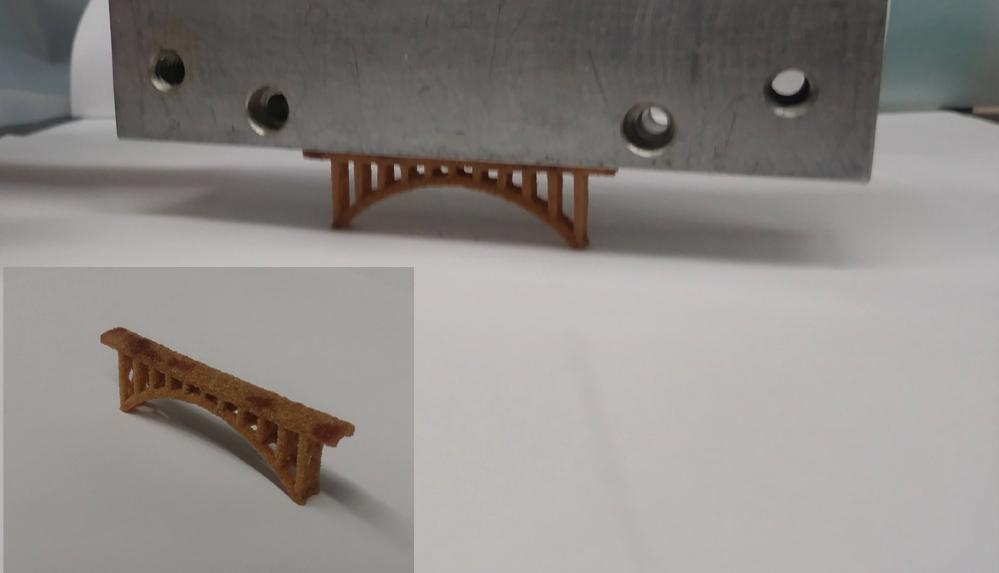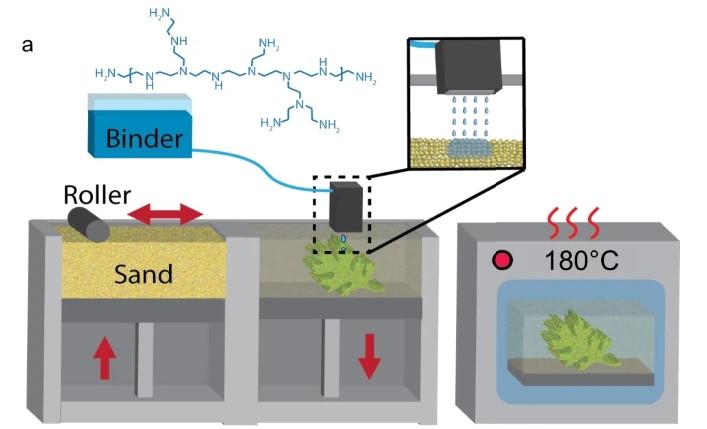- FMA
- The Fabricator
- FABTECH
- Canadian Metalworking
Our Publications
Categories
- Additive Manufacturing
- Aluminum Welding
- Arc Welding
- Assembly and Joining
- Automation and Robotics
- Bending and Forming
- Consumables
- Cutting and Weld Prep
- Electric Vehicles
- En Español
- Finishing
- Hydroforming
- Laser Cutting
- Laser Welding
- Machining
- Manufacturing Software
- Materials Handling
- Metals/Materials
- Oxyfuel Cutting
- Plasma Cutting
- Power Tools
- Punching and Other Holemaking
- Roll Forming
- Safety
- Sawing
- Shearing
- Shop Management
- Testing and Measuring
- Tube and Pipe Fabrication
- Tube and Pipe Production
- Waterjet Cutting
Industry Directory
Webcasts
Podcasts
FAB 40
Advertise
Subscribe
Account Login
Search
Polymer significantly increases the strength of 3D-printed sand structures
- November 12, 2021
- News Release
- Additive Manufacturing

ORNL’s new polymer-sand material allows this 6.5-cm bridge, made by binder-jet printing, to support 300 times its own weight. That is analogous to the Brooklyn Bridge holding 12 Empire State Buildings. ORNL
Researchers at the Department of Energy’s Oak Ridge National Laboratory (ORNL) have designed a polymer that gives exceptional strength to silica sand used for binder-jetting parts.
The ORNL team used its knowledge of polymers to tailor a polyethyleneimine, or PEI, binder that doubles the strength of sand parts compared with conventional binders.
According to the results of a study published in Nature Communications, the researchers 3D-printed a 6.5-cm-long bridge from a mixture of sand and the new polymer that supported 300 times its own weight. The feat, wrote the researchers, is analogous to the Brooklyn Bridge holding 12 Empire State Buildings.
Parts printed via binder jetting are initially porous when removed from the print bed. They can be strengthened by infiltrating the design with an additional bonding material, called a cyanoacrylate, that fills in the gaps. This second step provided an eight-fold strength increase on top of the first step, making the ORNL polymer-sand composite stronger than any known building material, including masonry.
“Few polymers are suited to serve as a binder for this application,” said ORNL’s Tomonori Saito, a lead researcher on the project. “We were looking for specific properties, such as solubility, that would give us the best result. Our key finding was in the unique molecular structure of our PEI binder that makes it reactive with cyanoacrylate to achieve exceptional strength.”
Silica sand is a cheap, readily available material that has been gaining interest in automotive and aerospace sectors for creating composite parts. A potential application for the super-strength sand is making composite tooling.
Lightweight materials, such as carbon fiber or fiberglass, are wrapped around 3D-printed sand cores, or “tools,” and cured with heat. Silica sand is attractive for tooling because it does not change dimensions when heated and allows for the manufacture of washable tooling. In composite applications, using a water-soluble binder to form sand tools is significant because it enables a simple washout step with tap water to remove the sand, leaving a hollow composite form.
Dustin Gilmer, a University of Tennessee Bredesen Center student and the study’s lead author, said, “To ensure accuracy in tooling parts, you need a material that does not change shape during the process, which is why silica sand has been promising. The challenge has been to overcome structural weakness in sand parts.”
Current sand-casted molds and cores have limited industrial use because commercial methods, such as washout tooling, apply heat and pressure that can cause sand parts to break or fail on the first try. Stronger sand parts are needed to support manufacturing at a large scale and enable rapid part production.
“Our high-strength polymer-sand composite elevates the complexity of parts that can be made with binder jetting methods, enabling more intricate geometries, and widens applications for manufacturing, tooling, and construction,” said Gilmer.
- Podcasting
- Podcast:
- The Fabricator Podcast
- Published:
- 04/16/2024
- Running Time:
- 63:29
In this episode of The Fabricator Podcast, Caleb Chamberlain, co-founder and CEO of OSH Cut, discusses his company’s...
- Trending Articles
- Industry Events
16th Annual Safety Conference
- April 30 - May 1, 2024
- Elgin,
Pipe and Tube Conference
- May 21 - 22, 2024
- Omaha, NE
World-Class Roll Forming Workshop
- June 5 - 6, 2024
- Louisville, KY
Advanced Laser Application Workshop
- June 25 - 27, 2024
- Novi, MI

























